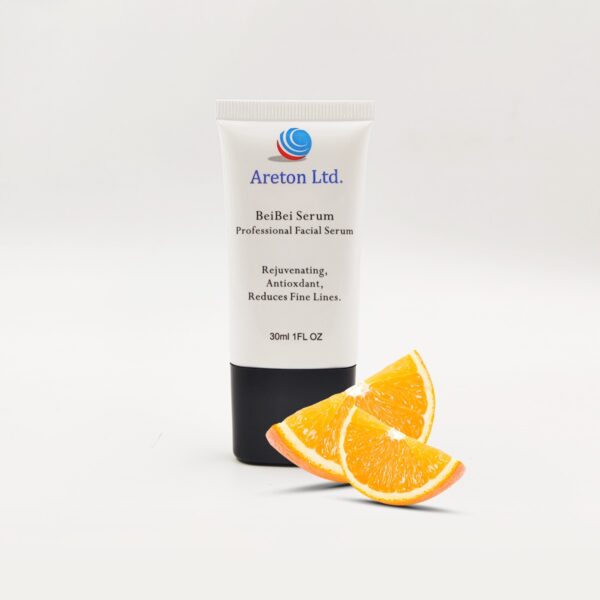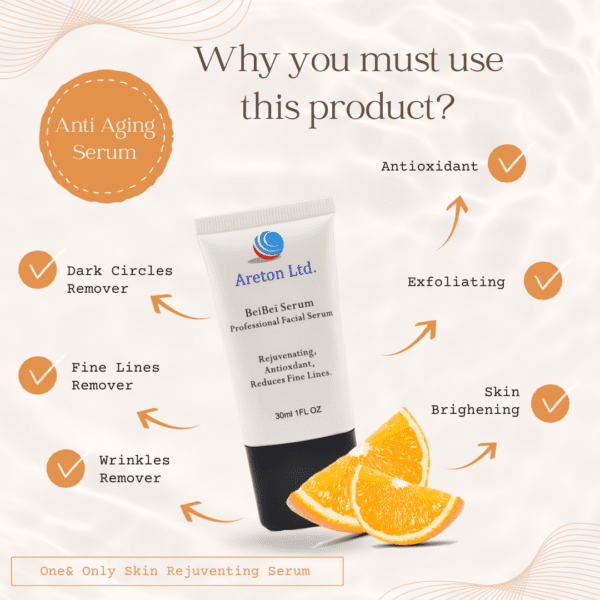[vc_row][vc_column][vc_column_text]
Overview
Rhytides, another name for wrinkles, are folds in your skin. The skin produces less collagen and elastin as you get older. Your skin becomes thinner and less protective as a result. Toxins, dehydration, and exposure to the environment can all increase the likelihood that you’ll have pronounced wrinkles on your face. There’s no need to fear developing wrinkles because they are a normal aspect of growing older. However, there are natural ways to slow down the effects of ageing on your face.
What to know about wrinkles
A wrinkle is a fold, ridge, or furrow in the skin. They develop inevitably as people age.
On a person’s face, the earliest lines frequently develop where the skin naturally folds during expressions. They grow as a result of the skin losing its elasticity and getting thinner over time.
Additionally, areas of the body that are exposed to the sun the most, such as the face, neck, hands, and arms, are more prone to developing wrinkles.
Everyone experiences wrinkles as a normal byproduct of ageing. Although many individuals loathe the way wrinkles look, the anti-aging sector in the United States is worth more than $50 billion annually.
In this essay, we will examine the causes, effects, and consequences of wrinkles. It also examines certain techniques for wrinkle reduction, some of which are more successful than others.[/vc_column_text][vc_single_image image=”9218″ img_size=”full”][/vc_column][/vc_row][vc_row][vc_column][vc_column_text]
What causes wrinkles ?
The ageing process is naturally accompanied by wrinkles. People’s skin grows thinner, drier, and less elastic as they age, making it less equipped to defend themselves from harm. As a result, the skin develops lines, creases, and wrinkles.
Facial expressions like smiling, frowning, or squinting cause fine lines and wrinkles to appear early in life. As a person ages, these lines become more pronounced.
Skin springs back when a person is young. The skin gets less elastic as people age, making it harder for the skin to rebound, which leads to permanent grooves.
Due to structural and functional variations in the skin, wrinkles have a distinct impact on persons with varying skin tones. According to a ResearchTrusted Source, the compact dermis is thicker in the skin of Black and Asian people, perhaps acting as a preventative measure against face wrinkles.
Wrinkles are influenced by a variety of variables, including:
• sun exposure
• smoking
• dehydration
• some medications
• environmental and genetic factors
[/vc_column_text][vc_single_image image=”9220″ img_size=”full”][vc_column_text]The appearance of wrinkles is accelerated by ultraviolet (UV) light exposure from outdoor activities such as sunbathing, tanning beds, and sports.|
The collagen and elastin fibres in the skin are destroyed by UV radiation. The connective tissue that supports the skin is made up of these fibres. The skin loses strength and flexibility as this layer degrades. Wrinkles start to develop as the skin begins to sag.
More melanin is present in darker skin, which also shields against many negative UV radiation impacts.
Early wrinkles are more likely in those who work in the sun. Wrinkles may take longer to form if you wear covering clothing, including caps or long sleeves.
Smoking frequently decreases the blood circulation to the skin, hastening the ageing process of the skin. Alcohol dries out the skin, and wrinkles are more likely to appear on dry skin.[/vc_column_text][/vc_column][/vc_row][vc_row][vc_column][vc_column_text]
Treatment
There are numerous treatments available to deal with skin’s fine wrinkles. A person may need more extreme methods, such plastic surgery or filler injections, for deeper wrinkles.
Medications
Retinoids used topically come from vitamin A. They seek to lessen hyperpigmentation, fine wrinkles, and rough skin. They accomplish this by boosting the skin’s collagen production.
The skin must be protected when using the cream because retinoids can cause the skin to burn in sunlight. Possible negative outcomes include:
• dryness
• itching
• a burning sensation
• tingling
• discolored areas
[/vc_column_text][vc_single_image image=”8904″ img_size=”full”][vc_column_text]The types and concentrations of the active components in wrinkle creams differ. OTC wrinkle creams will have substantially lower concentrations than prescription creams. How well they operate will depend on the concentration.
People may notice slight-to-modest results from the following medications:
• retinol
• alpha hydroxy acids
• kinetin
• coenzyme Q10
• copper peptides
• antioxidants
Dermabrasion
Dermabrasion is a surgical operation that uses a quickly rotating instrument to carefully wear away, or abrade, the top layers of skin. Dermabrasion seeks to get rid of scars of all kinds, including small wrinkles, moles, tattoos, and acne scars.
Scabbing, edoema, and changes in skin tone could result with this surgery. Although most of these symptoms go away after two weeks, some may last for several months.
A person may take several months to see any improvements and may not immediately get the desired outcomes.
A less intrusive treatment is microdermabrasion. It includes sprinkling aluminium oxide microcrystals on the skin’s surface. Some practitioners suction the debris off the skin while they brush it with a handheld instrument that contains tiny diamond crystals.
With this kind of therapy, the skin is intended to look younger and smoother and the appearance of wrinkles, enlarged pores, coarse skin, and sun damage is minimised.The effects are only transient, and patients could need additional therapies.
The epidermis is unharmed by non-ablative lasers, RF gadgets, and pulsed light sources.
In order to reduce wrinkles, laser and light source therapy treatments remove the skin’s outer layer.
The underlying dermis is heated by radiofrequency (RF) treatments, which also promote the growth of new collagen fibres. This reduces wrinkles and tightens the skin. After receiving RF treatment, it could take a while before someone observes a reduction in wrinkles. Over 90% of participants in a 2013 studyTrusted Source who had RF were happy with the outcomes at 1 month and 6 months after treatment. A wound is not produced by RF. However, the researchers recommended additional research into security and efficiency.
The new skin is smoother and tighter when it has recovered from laser or light surgery. Ablative laser resurfacing can take many months to heal; however, newer laser-based procedures may have a quicker recovery time.
Although recovery times are quicker, a person may require multiple treatments before their skin feels firmer and looks revitalised.[/vc_column_text][vc_single_image image=”9223″ img_size=”full”][/vc_column][/vc_row][vc_row][vc_column][vc_column_text]
Botox
The chemical signals that drive muscles to contract are blocked with botulinum toxin type A, more commonly known as Botox. Some medical disorders are treated with it by doctors.
By injecting tiny amounts of Botox into certain muscles, a cosmetic specialist can use it to minimise wrinkles. When the muscles are unable to contract further, the skin flattens, appearing less wrinkled and more smooth.
Botox can lessen forehead lines, frown lines in the area between the eyes, and “crow’s feet” around the eyes.
The American Society of Plastic Surgeons states that results usually appear within a few days to a week. Many people have further injections because the changes often persist 3 to 4 months.
Chemical peels
A chemical solution is applied to the desired locations during a chemical peel, causing the dead skin to slough and finally peel off. The new skin usually has a smoother texture than the previous skin.
Some chemical peels can be purchased by consumers without a medical licence. To get the finest care, you should, however, speak with a medical expert.
Facelift
A facelift, also known as a rhytidectomy, is a kind of cosmetic procedure that tries to make patients seem younger. Typically, some facial skin and fat are removed, and the underlying tissues may or may not be tightened.
According to a research published in Plastic and Reconstructive Surgery, a facelift’s effects should endure for roughly five and a half years, however they may start to fade around the neck.
The recovery process could take a while, and the patient will likely endure swelling and bruising for a few weeks following surgery.
Fillers
Fat, hyaluronic acid, and collagen are examples of soft tissue fillers. Fillers are injected by a cosmetic specialist into deeper facial creases to smooth them out and add volume to the skin.
Occasionally, people may develop temporary bruising and swelling in the afflicted areas. These therapies, like Botox, are only temporary, and some people may need ongoing injections.
The depth and location of the creases are important determinants of the outcomes.[/vc_column_text][/vc_column][/vc_row][vc_row][vc_column][vc_column_text]
Home remedies for wrinkles
Wrinkles are a fully natural effect of volume loss and aged skin. Because less collagen and elastin proteins are produced with time, the skin gets thinner. The skin’s resistance to injury also decreases as a result of this slowing.
A person can take some steps at home to reduce the likelihood of getting wrinkles or to hasten the process of anti-aging.
Daily skin care
Regular moisturising can keep the skin from becoming dry, which reduces the likelihood of wrinkles developing. It’s crucial to introduce one skin care product at a time and utilise products that are tailored to the skin’s demands.
Utilizing an excessive amount of skin care products, particularly many anti-aging creams, can irritate the skin and accentuate the indications of ageing. Most goods take a few weeks to start working.
Sleep
According to studies, some sleeping positions can increase the likelihood of facial wrinkles.
There are ways to lessen the possibility of wrinkling as you sleep. They include: using a silk pillowcase, despite the lack of studies to support this trend; resting flat on one’s back; using a specific pillow that prevents facial distortion while sleeping; and sleeping on one’s stomach.
[/vc_column_text][vc_single_image image=”9225″ img_size=”full”][vc_column_text]
Microneedling
Microneedling was originally only performed by professionals, but now anyone can do it themselves at home.
In microneedling, the skin is punctured with microscopic needles. The skin cells are renewed and the punctures start a healing process.[/vc_column_text][/vc_column][/vc_row][vc_row][vc_column][vc_column_text]
Prevention
Everybody gets wrinkles and lines that become more prominent over time. Some ways to prevent or reduce their development include:
• Wearing sunscreen. Skin damage can be decreased by avoiding UV rays. Dermatologists advise daily use of sunscreen with an SPF of 30 or higher, as well as protective clothing and headwear.
• Using moisturiser frequently. Dryness is avoided by moisturising, which lowers the likelihood of wrinkles developing.
• Giving up smoking. Smoking creates wrinkles and significantly accelerates skin ageing.
• Reducing alcohol intake. Alcohol causes the skin to become dehydrated, which over time damages it.
• Consuming a nutritious, balanced diet. In contrast to sugar and refined carbohydrates, which hasten skin ageing, eating a lot of fruit and vegetables can prevent skin damage.
• Using a face wash twice day. Make use of a mild cleaner. Rubbing the skin can irritate it and hasten the ageing process.
• Washing your face after you’ve perspired a lot. Sweat can irritate the skin, which over time can harm it. This is particularly valid if you’re wearing a hat or helmet.[/vc_column_text][/vc_column][/vc_row][vc_row][vc_column][vc_column_text]
Wrinkles in different areas of the body
People typically visualise face wrinkles when they think of wrinkles. However, wrinkles can appear on many parts of the body.
Most wrinkles typically develop on the face, neck, backs of the hands, and arms because these are the areas that are exposed to the sun the most.
Hands
Daily hand sunscreen use helps stop the development of wrinkles. Using retinol or glycolic acid-containing hand lotion before night is one method of treating hand wrinkles.
• getting laser treatment; having a minor chemical peel every one to three months
Decolletage
Chest skin is more vulnerable to UV damage than the skin on the rest of the body because it is thinner.
Nearly all procedures for the face, such as microneedling, lasers, chemical peels, and specific fillers, are equally safe for the chest area.
Summary
The natural ageing process includes wrinkles. The wrinkles start out as fine lines and gradually get worse as the skin loses its flexibility.
To get rid of wrinkles, people might employ a variety of therapies. Wrinkles may be avoided or delayed by making lifestyle changes like moisturising, using sunscreen, eating a healthy diet, quitting smoking, and drinking less alcohol.[/vc_column_text][/vc_column][/vc_row][vc_row][vc_column][vc_column_text]
Areton Anti Wrinkles Products
[/vc_column_text]





